KING HAROLD OF ENGLAND WAS
KILLED BY VIKING KING HARALD HARDRADA OF NORWAY AT THE BATTLE OF STAMFORD BRIDGE ON SEPTEMBER 25,1066. HARDRADA MEANS "RUTHLESS," AND HE BELIEVED THAT HE
WAS THE VIKING CONSTANTINE, DESTINED TO ANNEX ENGLAND TO THE PAPAL ROMAN EMPIRE!! |
The Old Covenant strong conspiracy happened about 950 BC when King David's son Absolom conspired to kill his own father and take over the kingdom. Absolom's mother was named Maachah (rebellion), the daughter of Talmai, king of Geshur:
And Absalom sent for Ahithophel the Gilonite, David's counsellor, from his city, even from Giloh, while he offered sacrifices. And the conspiracy was strong; for the people increased continually with Absalom. And there came a messenger to David, saying, "the hearts of the men of Israel are with Absalom" (II Samuel 15:12-13).
Those men of Israel were circumcised, and kept a kosher diet, but that didn't prevent them from rebelling against their lawful king.
That strong conspiracy failed, and Absolom was killed, but not before thousands of Isrealites were slain at the Battle of the Wood of Ephraim.
The strong conspiracy called "Operation Babylonian Captivity" was accomplished in just one year and it took split second timing. The year 1066 was not chosen at random. King Nebuchadnezzar's statue was 60 cubits high and 6 cubits wide (Daniel 3:1). The image in Daniel Chapter 2 had 10 toes, and the beast in Daniel Chapter 7 had 10 horns. Additionally, the Apocalypse predicted intense Satanic activity after the year 1000:
And when the thousand years shall be finished, Satan shall be loosed out of his prison, and shall go forth, and seduce (Gk. planeō: deceive) the nations, which are over the four quarters (Gk. gonia: corners) of the earth, Gog and Magog, and shall gather them together to battle, the numbers of whom is as the sand of the sea (Apocalypse 20:7, Douay-Rheims Version).
The Bayeux Tapestry is a complete fabrication. King Harold was not killed at the "Battle of Hastings" in 1066 because the "Battle of Hastings never happened. Duke William (the so-called Conqueror), landed unopposed, and then marched his army to London accompanied by the plunder of the surrounding countryside!
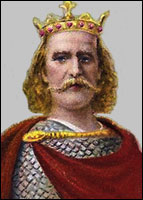 King Harold of England (1022–Sept. 25, 1066). |
|
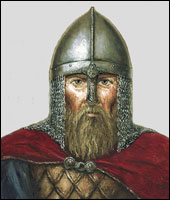 " Ruthless" King Harald of Norway (1015–????). |
King Harold was not only betrayed by the Babylonian hierarchy, but his own sister Edith, and brother Tostig, conspired against him.
Ruthless Viking Hardrada had a half-brother named Olaf Haraldsson who was canonized by Pope Alexander III. It is not an exaggeration to say that the Vikings killed as many Christians as the Muslims.
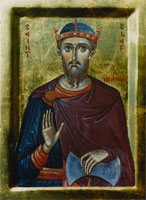 "Saint" Olaf (995–1030) holding his battle axe. |
|
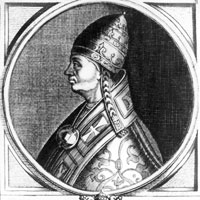 Pope Alexander III (1105–1181). Reigned from 1159 to 1181. |
Coincidently, it was Saint Paul who introduced Christianity to Britannia around 66 AD. Christianity was so firmly planted on Christ the Rock that it took Apollyon about 1000 years to undermine it.
Viking Harald Sigurdsson was a man of war from his youth, having first gained experience in the newly emerging country of Russia, and then as a Byzantine bodyguard.
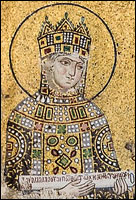 Empress Zoe (978–1050). Reigned from 1028 to 1050. |
|
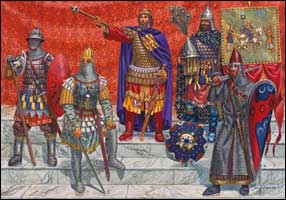 The Varangian Guard in the Byzantine Empire. |
During the next 20 years, the berserker fought all over the Middle East, plundering the wealth of the people, and sending it back to Norway to finance his fellow Viking terrorists.
Harald was just as involved in the Byzantine politics of Constantinople as he would later become in English affairs.
Harald Hardrada blinded the eyes of Byzantine Emperor Michael V
The reign of Empress Zoe was one of the most corrupt times in the Byzantine Empire. With "Ruthless" in charge of her personal bodyguard, all of her rivals were brutally eliminated.
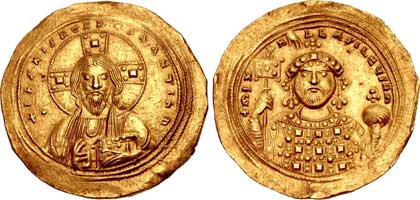 Coins of Emperor Michael IV. Puppet ruler from 1034 to 1041. |
|
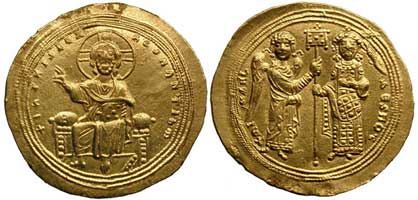 Coins of Michal V. Ruled from Dec. 1041 Coins of Michal V. Ruled from Dec. 1041to his blinding in April 1042. |
In April 1042, Michael IV was overthrown by Michael V; Zoe was sent to a nunnery, and the corrupt Harald was arrested and thrown into prison.
During that palace revolution, the streets of Constantinople ran red with blood. Harald Hardrada was arrested and thrown into prison. However, he was able to escape, and then he launched a counter-revolution against Emperor Michael. The deposed emperor fled to a monastery for sanctuary, but he was dragged out and blinded by Harald:
Ultimately the palace fell, the Varangians guarding the emperor being defeated by the Varangians revolting against him, led by Harald Hardrada. The palace was vandalized, and Michael V, who sought sanctuary in the Studion chapel, was dragged to the square where he was blinded and exiled to a monastery. The sagas report that it was Harald Hardrada who gouged out the emperor's eyes. (DeVries, The Norwegian Invasion of England in 1066, pp. 36-37).
After the counter-revolution, Empress Zoe returned from the nunnery, and the 64-year-old found a new husband named Constantine IX Monomachus. She continued to rule with that puppet until her death in 1050.
Harald managed to escape back to Norway via Russia, with all the loot he had stolen in Constantinople. As usual, he poisoned or fought his way to the throne, and became king of Norway in 1046.
The Battle of Milvian Bridge and the Battle of Stamford Bridge
The infamous Battle of Milvian Bridge took place in October 312. Instead of staying behind the secure walls of the city, the Romans under Maxentius came out and gave battle in the open. That was a fatal mistake, and Maxentius was defeated and drowned in the Tiber.
|
There are many similarities between Hardrada and Constantine. Both men were GIANTS physically, and both men were totally ruthless. When they weren't fighting, both men devoted their time to literary pursuits. Additionally, both men spent a lot of time in the city called by the name of the emperor.
The Battle of Stamford Bridge took place on September 25, 1066, near York, England. York was the original birthplace of Emperor Constantine.
 The Battle of Stamford Bridge in September 1066. |
|
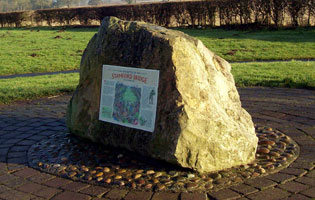 A very modest monument to the history-changing battle. |
Nothing could stop the berserk Viking warriors, who were high on drugs and alcohol when they went into battle. Additionally, they possessed supernatural strength from their father Apollyon:
After the battle, the bodies of thousands of Englishmen and Norwegians were left in the field where they had fallen; more than half a century later, Orderic Vitalis wrote that travellers could recognize the site on account of the great mountain of dead men's bones. (Morris, The Norman Conquest, p. 165).
King Harold and his 2 brothers were among that great mountain of corpses....After the battle it was announced far and wide that King Harold was dead. A king Harold was dead indeed . . . but it was not King Harald Hardrada.
The Battle of Hastings never happened!
The celebrated Battle of Hastings never occurred. Even if King Harold survived the Battle of Stamford Bridge, there was not enough time for him to race down and confront Duke William at Hastings:
The king's location is important because it determines how much time he had to react. From Pevensey to York is approximately 270 miles; if the Normans landed in the morning of September 28, news can hardly have reached him before 1 October. Looking ahead for a moment to one indisputable date, the Battle of Hastings took place 14 October. Harold, in other words, moved from Yorkshire to the Sussex coast in barely a fortnight (Morris, The Norman Conquest, p. 172).
In the age before trains and cars, such rapid mobility was an impossibility.
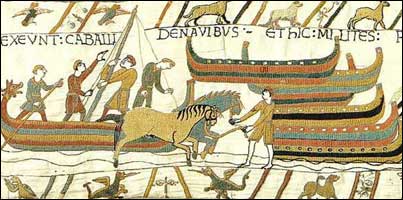 The Normans disembarking their horses. |
|
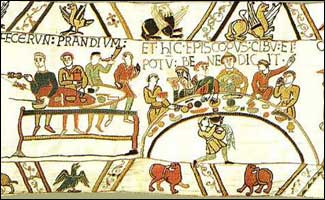 Bishop Odo giving thanks for the food Bishop Odo giving thanks for the food after the Normans disembarked. |
Bishop Odo (half-brother of Duke William), had a very good reason for giving thanks because he knew that King Harold, and most of the English nobles, were already dead.
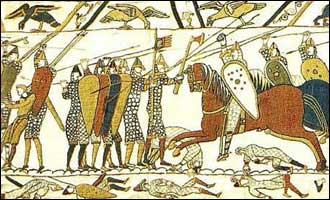 The so-called "Battle of Hastings" as depicted on the tapestry. |
|
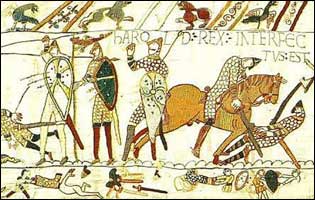 King Harold pulling an arrow out of his eye and then receiving a sword slash on his thigh. |
According to the tapestry, King Harold was killed by an arrow in his eye. Harold Hardrada was the one who was accustomed to blinding his enemies. Most likely King Harod was slain by the axe of a brutal Viking beserker.
 This scene shows the English fleeing before the soldiers of Duke William. |
|
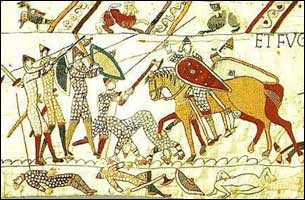 The Normans exulting over their illusory fallen foes. |
The king of England did not have to wear the LION SYMBOL to make him brave. His soldiers fought to the very last man. In those days, taking prisoners was not an option. If you didn't surrender before the battle, the only other option was death . . . or fleeing.
Except for a few minor skirmishes, the army of Duke William marched proudly and unopposed to London.
Duke William became "William the Conqueror" without winning a single battle!
It is beyond belief but Duke William became "William the Conqueror" without fighting and winning a single battle. Even back then "fake news" was pandemic, and the duke became a "war hero" without even trying.
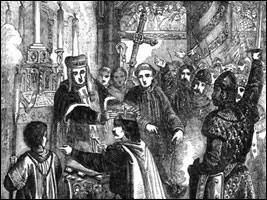 An artistic depiction of the crowning of Duke William. |
|
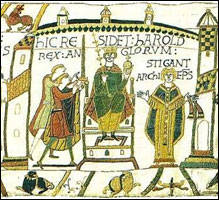 Archbishop Ealdred crowned King Harold and Duke William. |
Archbishop Ealdred crowned King Harold, and also his replacement:
William's coronation adhered to long-standing English traditions. Anthems in praise of the king were sung, just as they had been in the Confessor's day, and the service was conducted by an English archbishop. As at the start of the year, this was Ealdred, archbishop of York, rather than Stigand, the pariah archbishop of Canterbury. (Morris, The Norman Conquest, p. 199).
Pope Alexander III officially annexed England to the Papacy when he appointed an Italian canon lawyer as archbishop of Canterbury. The canon law of the Papal hierarchy became the law of the land, and the just and equitable laws of the Anglo-Saxons were trampled underfoot.
 Stone statue of Archbishop Lanfranc in Canterbury Cathedral. |
|
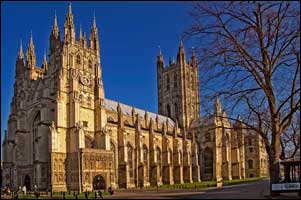 Canterbury Cathedral was rebuilt Canterbury Cathedral was rebuiltBabylonian style after the Captivity. |
From lands confiscated from the Anglo-Saxons, the Normans went on a frenzy of STONE construction. Castles, monasteries, nunneries, etc., etc., etc. The most formidable fortress still standing is the Tower of London, which was used to imprison those who were not killed or blinded.
The Jewish Messiah was a CARPENTER . . . and not a mason. Additionally, the Messiah died on a LIVING TREE. . . and not on a piece of DEAD WOOD.
The Normans were just Vikings with a face lift. The word NORMAN is derived from NORTHMAN, and the Prophet Jeremiah predicted that desolation would come from the NORTH:
Then JEHOVAH said unto me, "out of the north and evil shall break forth upon all the inhabitants of the land" (Jeremiah 1:14).
The mighty Prophet Jeremiah also advises Christians to prepare for the Battle of Armageddon and the Last Day by fleeing from the spiritual Babylon:
Flee out of the midst of Babylon, and deliver every man his soul: be not cut off in her iniquity; for this is the time of JEHOVAH's vengeance; he will render unto her a recompense (Jeremiah 51:6).

